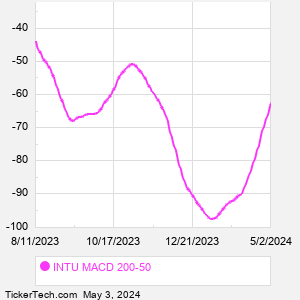Intuit helps consumers and small businesses by delivering financial management, compliance, and marketing products and services. Co.'s segments are: Small Business and Self-Employed, which serves small businesses and the self-employed, and the accounting personnel who assist and advise them; Consumer, which serves consumers and includes do-it-yourself and assisted TurboTax income tax preparation products and services sold in the U.S. and Canada; Credit Karma, which serves consumers with a personal finance platform that provides personalized recommendations of credit card, home, auto, and personal loan, and insurance products; and ProTax, which serves accountants in the U.S. and Canada.
When researching a stock like Intuit, many investors are the most familiar with Fundamental Analysis — looking at a company's balance sheet, earnings, revenues, and what's happening in that company's underlying business. Investors who use Fundamental Analysis to identify good stocks to buy or sell can also benefit from INTU Technical Analysis to help find a good entry or exit point. Technical Analysis is blind to the fundamentals and looks only at the trading data for INTU stock — the real life supply and demand for the stock over time — and examines that data in different ways. One of those ways is to calculate a Simpe Moving Average ("SMA") by looking back a certain number of days. One of the most popular "longer look-backs" is the INTU 200 day moving average ("INTU 200 DMA"), while one of the most popular "shorter look-backs" is the INTU 50 day moving average ("INTU 50 DMA"). A chart showing both of these popular moving averages is shown on this page for Intuit. Comparing two moving averages against each other can be a useful visualization tool: by calculating the difference between the INTU 200 DMA and the INTU 50 DMA, we get a moving average convergence divergence indicator ("INTU MACD"). The INTU MACD chart, in conjunction with the chart of the moving averages, basically helps in visualizing how the moving averages are showing convergence (moving closer together), or divergence (moving farther apart). |



